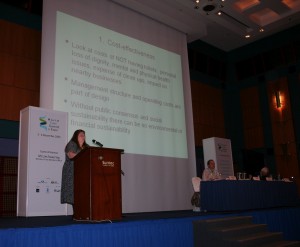Barb Lescher presents the PHLUSH Design Principles
Here in one of the cleanest cities of the world, PHLUSH Co-Founder Barbara Lescher presented Public Restroom Design for 21st Century US Cities: The PHLUSH Principles. These design principles were passed by the Old Town Chinatown Neighborhood Association in June 2008 after extensive discussion in the community and by the neighborhood’s the Visions Committee.
 The working goal of the PHLUSH Public Restroom Design Principles is the following: Cost effective public restrooms that provide maximum function in minimum space and are safe, accessible, available, attractive and easy to maintain. Following an introduction, Barb presented each of seven principles and illustrated with best practices in restroom design form various parts of the United States.
The presentation was part of a session entitled “Design and Technology for the Built Environment: Designs for Social Impact.” Following her presentation, Barb responded to questions as part of a panel moderated by Christoph Luthi of EAWAG. Other panelists included Dr. Asiah Abdul Rahim of the International Islamic University of Malaysia and Architect Frank Wu, who serves as Chair of the Taipei Toilet Association.
The working goal of the PHLUSH Public Restroom Design Principles is the following: Cost effective public restrooms that provide maximum function in minimum space and are safe, accessible, available, attractive and easy to maintain. Following an introduction, Barb presented each of seven principles and illustrated with best practices in restroom design form various parts of the United States.
The presentation was part of a session entitled “Design and Technology for the Built Environment: Designs for Social Impact.” Following her presentation, Barb responded to questions as part of a panel moderated by Christoph Luthi of EAWAG. Other panelists included Dr. Asiah Abdul Rahim of the International Islamic University of Malaysia and Architect Frank Wu, who serves as Chair of the Taipei Toilet Association.
 The working goal of the PHLUSH Public Restroom Design Principles is the following: Cost effective public restrooms that provide maximum function in minimum space and are safe, accessible, available, attractive and easy to maintain. Following an introduction, Barb presented each of seven principles and illustrated with best practices in restroom design form various parts of the United States.
The presentation was part of a session entitled “Design and Technology for the Built Environment: Designs for Social Impact.” Following her presentation, Barb responded to questions as part of a panel moderated by Christoph Luthi of EAWAG. Other panelists included Dr. Asiah Abdul Rahim of the International Islamic University of Malaysia and Architect Frank Wu, who serves as Chair of the Taipei Toilet Association.
The working goal of the PHLUSH Public Restroom Design Principles is the following: Cost effective public restrooms that provide maximum function in minimum space and are safe, accessible, available, attractive and easy to maintain. Following an introduction, Barb presented each of seven principles and illustrated with best practices in restroom design form various parts of the United States.
The presentation was part of a session entitled “Design and Technology for the Built Environment: Designs for Social Impact.” Following her presentation, Barb responded to questions as part of a panel moderated by Christoph Luthi of EAWAG. Other panelists included Dr. Asiah Abdul Rahim of the International Islamic University of Malaysia and Architect Frank Wu, who serves as Chair of the Taipei Toilet Association.
As cities in the United States strive to enhance livability, create vibrant business districts, promote public transportation, persuade commuters to walk or bicycle, support healthy living and active aging, they need public toilets. Today, however, there is a crisis in toilet availability in the shared space of the commons. Many facilities in parks and public spaces in US cities have been closed permanently or function only limited hours. As costs of managing and maintaining poorly designed restrooms have escalated, they have been stricken from local government budgets. At the same time, urban planners, architects, and designers have paid inadequate attention to public toilets and to changing societal needs.
The working goal of the PHLUSH Public Restroom Design Principles is the following: Cost effective public restrooms that provide maximum function in minimum space and are safe, accessible, available, attractive and easy to maintain.
As cities in the United States strive to enhance livability, create vibrant business districts, promote public transportation, persuade commuters to walk or bicycle, support healthy living and active aging, they need public toilets. The PHLUSH Principles reply to a crisis in toilet availability. Many facilities in parks and public spaces in US cities have been closed permanently or function only limited hours. As costs of managing and maintaining poorly designed restrooms have escalated, they have been stricken from local government budgets. At the same time, urban planners, architects, and designers have paid inadequate attention to public toilets and to changing societal needs. 